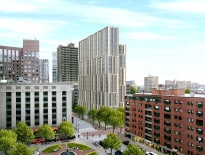
A 320,000-square-foot bank operations center in Malden Center will be revamped by Berkeley Investments, which is seeking office tenants to a new transit-oriented development cluster near the MBTA’s commuter rail and Orange Line station.
By now, most everyone has heard of the “live-work-play” development trend that’s sweeping Boston and other urban communities where there are still patches of land to build near transit lines.
But tearing down a city hall and police department facility – and completely transforming an aging hulk used for decades as a bank check-processing center – and replacing them with gleaming new residences, retail shops and new offices? That’s a new twist on a development trend.
But that’s exactly what’s happening in Malden, where the third piece of a major development puzzle is now falling into place. Boston-based Berkeley Investments is putting the finishing touches on designs to convert a 320,000-square-foot “fortress-like” building used for years by Bank of New England, FleetBoston and Bank of America as a check-processing and data center.
The goal: To open up the building with new glass curtain walls, a roof “light well” to bring in sunshine from the top and ground-floor retail, including cafes and restaurants, all of it to attract a new array of office tenants hungry for a “live-work-play” environment – but at more affordable rents than what they would pay in Boston and Cambridge.
But perhaps the biggest future draw of what’s now being branded as “Exchange 200” (at 200 Exchange St. in Malden) may lie across the street: The MBTA’s Orange and commuter lines station, which is expected to be the main generator and driver of interest in Berkeley’s converted Exchange 200 facility.
“Transit-oriented development is key these days,” said Phil Giunta, executive managing director at Newmark Knight Frank, which is working with Berkeley to market Exchange 200 to future tenants. “We’re already seeing interest from (potential) tenants.”
Another huge plus in Berkeley’s favor is just a block away, as the city of Malden and Jefferson Apartment Group begin to transform Malden’s own Government Center. The mayor, Gary Christenson, prefers referring to the old City Hall as the “Beast That Ate Pleasant Street,” located within a maze of one-way streets he calls “the mouse trap.”
Demolishing The Beast
In the first phase of the ambitious center project, the city has already demolished the old nearby police-department headquarters, constructing a new police facility elsewhere. And the old 130,000-square-foot City Hall – the brick-covered “beast” that was opened in the 1970s – is now currently being demolished. The city is currently housing its government employees in a rented building and a city-owned facility nearby.
Once the old City Hall is demolished, McLean, Virginia-based Jefferson Apartment Group can start the project’s second phase – construction of a mixed-used, two-building complex that, in the end, will include 320 apartment units and 22,000 square feet of retail space. The city is also poised to issue a request for construction bids for a smaller City Hall right next door, costing $14.2 million.
To Christenson, the nearby Berkeley Investment project is sort of the proverbial cherry on the cake after five years of intense debate and wrangling to transform Malden Center, he said.
Carolyn Zern, vice president of development at Berkeley who will act as project manager, said Bank of America still has some employees at 200 Exchange St. who are expected to move out later this summer. Otherwise, Berkeley is set to start construction, no later than next spring.
Stantec (formerly ADD Inc.) is the project architect while Dellbrook JKS is the general contractor. The conversion is expected to take about a year.
Dan McGrath, vice president of asset management at Berkeley, said there’s a lot to like about the future Exchange 200, previously owned by New York’s Gramercy Property Trust before Berkeley purchased it last year.
Chief among its pluses is the building’s big open spaces and its sturdiness, designed to handle the heavy loads associated with data centers.
Ultimately, Berkeley envisions the second, third and fourth floors being used for office tenants, while portions of the first and second floors might be retained as a data center, adhering to the building’s original purpose and design. The ground floor along Exchange and Commercial streets will contain 15,000 to 20,000 square feet of retail, most probably coffee shops and restaurants.
Already, Berkeley is seeing interest for space from tech firms and companies in need of back-office space, said McGrath and Giunta. “We’re seeing a mixture of users,” said Giunta.
McGrath said Berkeley is also hopeful it might be able to attract robotic and 3D printing companies that require expansive, sturdy floor space.








